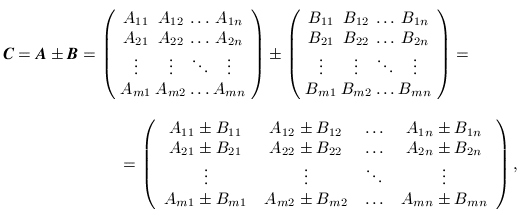![[IUCr Home Page]](/iucr-top/logos/iucrhome.gif)
![[Commission Home Page]](/iucr-top/logos/cteach.gif)
Matrices can be multiplied with a number or can be added, subtracted, and multiplied with each other. These operations obey the following rules:
Definition (D 2.4.5) An ![]() matrix A is multiplied with a
(real) number
matrix A is multiplied with a
(real) number ![]() by multiplying each element with
by multiplying each element with ![]() :
:
 .
.
Definition (D 2.4.5) Let ![]() and
and ![]() be the general elements of the
matrices A and B. Moreover, A and B must be of the
same size, i.e. must have the same number of rows and of columns.
Then the sum and the difference
be the general elements of the
matrices A and B. Moreover, A and B must be of the
same size, i.e. must have the same number of rows and of columns.
Then the sum and the difference
![]() is defined by
is defined by

i.e. the element ![]() of C is equal to the sum or
difference of the elements
of C is equal to the sum or
difference of the elements ![]() and
and ![]() of A and B
for any pair of
of A and B
for any pair of ![]() :
:
![]() .
.
The definition of matrix multiplication looks more complicated at first sight
but it corresponds exactly to what is written in full in the formulae
(2.2.1) to (2.2.4) of Section 2.2. The multiplication of
two matrices is defined only if the number ![]() of columns of the
of columns of the
![]() ft
ft ![]() trix is the same as the number
trix is the same as the number ![]() of rows of the
of rows of the ![]() ght
ght
![]() trix. The numbers
trix. The numbers ![]() of rows of the
of rows of the ![]() ft
ft ![]() trix and
trix and ![]() of columns of the
of columns of the ![]() ght
ght ![]() trix are free.
trix are free.
We first define the product of a matrix A with a column a:
Definition (D 2.4.5) The multiplication of an (![]() ) matrix A
with an (
) matrix A
with an (![]() ) column a is only possible if the number
) column a is only possible if the number ![]() of
columns of the matrix is the same as the length of the column a. The
result is the matrix product d = A
of
columns of the matrix is the same as the length of the column a. The
result is the matrix product d = A![]() a which is a
column of length
a which is a
column of length ![]() . The
. The ![]() -th element
-th element ![]() of d is
of d is
Written as a matrix equation this is

In an analogous way one defines the multiplication of a row matrix with a general matrix.
Definition (D 2.4.5) The multiplication of a ![]() row a
row a
![]() ,
with an (
,
with an (![]() ) matrix A is only possible if the length
) matrix A is only possible if the length ![]() ,
i.e. the number of `columns', of
the row is the same as the number
,
i.e. the number of `columns', of
the row is the same as the number ![]() of rows of the matrix. The result is
the matrix product d
of rows of the matrix. The result is
the matrix product d
![]() = a
= a
![]() A which
is a row of length
A which
is a row of length ![]() . The
. The ![]() -th element
-th element ![]() of d
of d
![]() is
is
Written as a matrix equation this is

The multiplication of two matrices (both neither row nor column) is the combination of the already defined multiplications of a matrix with a column (matrix on the left, column on the right side) or of a row with a matrix (row on the left, matrix on the right side). Remember: The number of columns of the left matrix must be the same as the number of rows of the right matrix.
Definition (D 2.4.5) The matrix product
C = A![]() B, or
B, or

Examples.
If
 and
and
 ,
,
then
 . On the
. On the
other hand,
 .
.
Obviously, C![]() D, i.e. matrix multiplication is
not always commutative.
However, it is associative,
e.g., (AB)D =
A(BD), as the reader may verify by
performing the indicated multiplications. One may also verify that matrix
multiplication is distributive, i.e.
D, i.e. matrix multiplication is
not always commutative.
However, it is associative,
e.g., (AB)D =
A(BD), as the reader may verify by
performing the indicated multiplications. One may also verify that matrix
multiplication is distributive, i.e.
(A + B)C = AC + BC.
In `indices notation' (where A is an
![]() matrix, B an
matrix, B an ![]() matrix) the matrix
product is
matrix) the matrix
product is
Remarks.
Copyright © 2002 International Union of Crystallography
IUCr Webmaster